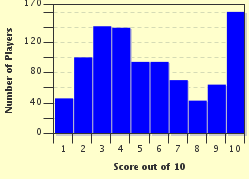Quiz Answer Key and Fun Facts
1. Note: The periodic table is arranged into vertical groups and horizontal periods.
Loonium and Burgium are found in the same period, but Burgium is in group 4, whereas Loonium is in group 2. What does this tell you?
2. Dazzium and Mimoium are both found in group 4, but Dazzium is in period 2, whereas Mimoium is in period 3. What does this tell us?
3. Glendium and Jabberium are also found in the same group, but Jabberium is in period 3, whilst Glendium is found in period 4. Concerning the atomic radii, which of the following is true?
4. Aerolancium is a noble gas in period 4 and Flopsium is a group 1 element in period 5. What behaviour is Flopsium most likely to exhibit?
5. Salamium and Emmium are both part of group 1 (also known as the alkali metals). Salamium is in period 2, whereas Emmium is in period 5. Which of these reacts more readily with Morphium, which is a halogen?
6. Alongside Morphium in the halogens (also known as group 7) are Annium and Terrium. Morphium is in period 2 and is a pale yellow gas. Annium is in period 4 and is a brownish liquid. Terrium is in period 6. Which of the following will most closely describe Terrium's physical characteristics?
7. Elainium and Kylium are both found in period 3, but Elainium is in group 2 and Kylium is in group 5. Which has a larger radius?
8. Babium is found in the transition block, whereas Bassium is in group 3. Which of the following can be said with certainty about these two elements?
9. Two members of group 7 are Aprilium (period 3) and Jamillium (period 5). Which is more reactive with Barnium (a group 1 element)?
10. The periodic table can also be divided into blocks, with the names "s", "p", "d" and "f", according the type of orbital in which their valence electrons are found. Noctulium is a transition metal, Qoolium is in group 2 and Exitium is in group 5 (also called group 15). Which of these is a "p-block" element?
Source: Author
doublemm
This quiz was reviewed by FunTrivia editor
CellarDoor before going online.
Any errors found in FunTrivia content are routinely corrected through our feedback system.

